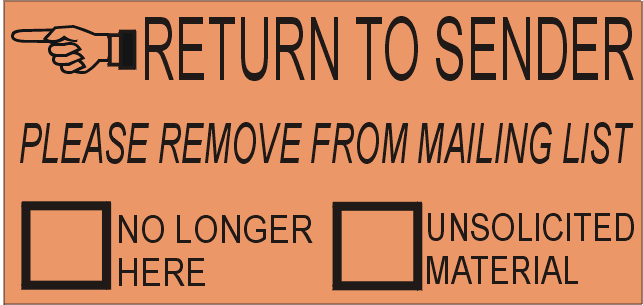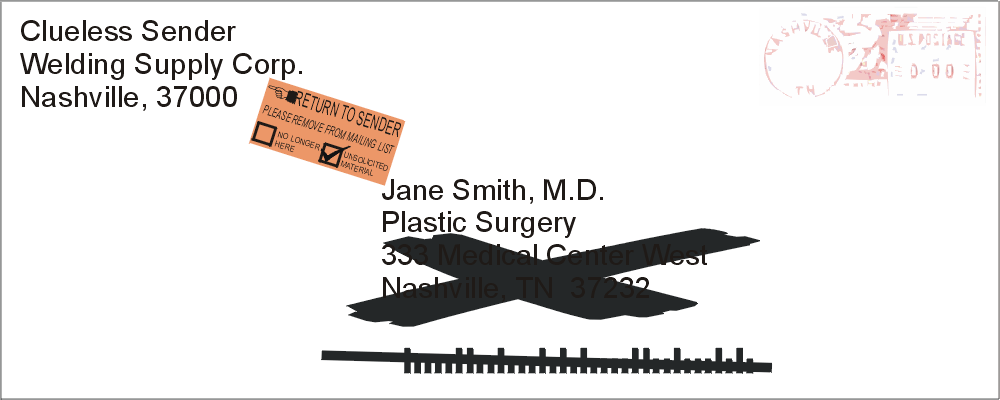| To
go to our change-of-address request page, click below:
New Address Request Page
| REQUESTING A NEW ADDRESS | AFTER RECEIVING
YOUR NEW ADDRESS |
|
Please notify the Post Office as early as
possible; about four to six weeks before your move is preferable.
The basics that we need to know are:
- your name;
- your extension;
- your e-mail;
- department name;
- current address and zip;
- new location;
- approximate move date;
- whether the whole department is moving or only part;
- whether there will be pneumatic tube service in the new location, and the station number if so.
The following points should be noted:
- A new department, for postal purposes, is considered to be the same as a move.
- In case of a department splitting up, a new name will need to be assigned to the area moving. Exact department names cannot be duplicated.
The Post Office will consult with you as needed in this case.
- Mail is routed chiefly by address/zip, so that changes will not be completely effective
until all senders have updated their files.
Once this information has been received and processed, the Post Office schedule
you for a training class, during which you will receive your new address, including new zip code if required,
and your initial supply of change-of-address stationery. If your building is one served by
mailboxes, you will also be assigned a box and given either a key or a
combination as appropriate.
This phase should be finished by about four weeks before your move.
|
Begin preparations to notify your correspondents. The Post Office sends
change-of-address stationery along with formal notification of your new
address, but if you need more, please order here.
A. About four weeks before moving:
- Notify senders of U.S. Mail. Begin with those large organizations likely to need most time to convert,
e.g. publishers, insurance companies, etc.
- Re-order new stationery, envelopes, and business cards. (With your VU
password and user name, you can order these online from University Printing
here.) If you use a rubber stamp for your return address,
re-order this as well.
- Ask those members of your staff who have Credit Union accounts to notify the Credit Union of their new address:
Credit Union, 107 Oxford House (4213). They have a PDF form you can download
and submit here. They will also accept changes by phone at 6-0300.
B. About two weeks before moving:
Notify persons and departments which send you campus mail.
Concentrate first on those areas whose operations most closely impact yours and from which
you receive most mail.
|
| CONTACTING YOUR CORRESPONDENTS |
|
If you have a list of your department's correspondents, you can begin using it
to spread the word of your new address. Many people find it convenient to
use phone or e-mail contact for this, but you can also send a note or postcard
by mail. If you don't have such a list, though, don't worry--your
incoming mail can be your guide. If you contact the sender of each piece
you receive for just a couple of weeks, you will probably cover most of the
persons and organizations who need to know.
If you decide to contact your senders by mail, you will need to locate the address to which change-of-address correspondence should be sent for each mailpiece.
For ordinary First Class U.S. Mail and most campus mail items, this is not difficult--the return address which
normally appears at the upper left corner should be used. If a mailing label is on the piece, the return address
may appear on the upper portion of the label.
Periodicals, including professional journals, always have a
change-of-address section (often in very small type), usually somewhere near the contents page,
but occasionally this will be on a back page instead. Newsletters and other informal publications
may place the return address on the face of the piece at the upper left, or almost anywhere inside.
If inside, it is usually fairly prominently marked and often enclosed by a box or border.
(The "Letters to the editor" section, if there is one, is a good place to check.)
DIRECTING YOUR LETTER TO THE PROPER PERSON OR DEPARTMENT
In general, "Mailing List Manager" is a good attention line to use. If you have access to the name of the person who is responsible for a particular
publication or database, use that instead. Do beware of institutional addresses from a very generic envelope or address label.
"Smith Hospital, Smithville, ST, 99999" may not get your request to the proper person if Smith Hospital has many departments
or branch locations. (Even here at Vanderbilt, "Pediatrics" with the central department address may not be useful if your
correspondent is actually in a subspecialty in another building.) In such a case, it is better to look further inside the mailpiece
for more specific information
as to who or what area actually initiated the mailing.
CAMPUS MAIL
There are some specific updates you will need to do with regard to campus mail.
- The most critical is the PeopleFinder/campus directory database
--responsibility
for updating this information is delegated to the departments.
Each one has a coordinator who is authorized to access and modify the
departmental and individual listings for that area, so you will need to
communicate with that person about your move. Fortunately, if you do not
know who this is, you can find out from
PeopleFinder itself.
Search for your department, and you will see the name of the person responsible
for your listing.
PLEASE NOTE: there does exist one type of campus mail on which you cannot change the address--campus-wide
mailings. To see why, click here.
OTHER WAYS OF COMMUNICATING
Don't neglect other means that may be available for letting your new address be known:
- If you produce a newsletter, make your move a prominent article and give your new address (in large type!).
- If your professional association or other affiliated group produces a publication, ask them to include this information.
- Write a short paragraph calling attention to the new address on your letterhead and add it onto
the bottom of the text of any letters you send (start as soon as you get your letterhead and continue several weeks after your move).
- If your fax has broadcast capacity, broadcast a move
announcement to all your stored numbers just before move day. (You may not find
the fax machine for quite a while afterward!)
|
| UNWANTED MAIL |
The process of examining your mail for address correction frequently reveals that a certain part
of the mail stream consists of unwanted or unsolicited items--"junk mail," in the most familiar term. This is the easiest category of problem mail to deal with.
During your move, or any time that this may be a concern,
the following can help.
A. FIRST CLASS
This mail can simply be returned to the sender without further payment of postage.
Your change-of-address packet will contain some orange stickers that make this easy (see illustration, at right).
 Do the following steps:
Do the following steps:
- Cross out the address and line through the bar code. This last is especially important,
or the automatic sorting equipment used by the U.S. Postal Service will read the code and
send it back to you again. (To learn about another instance in which automated sorting can
return an outgoing item to you, click here).
- Place the sticker prominently on the front of the item, pointing to the return address, as
shown below.

There are spaces on the sticker to indicate, if you wish, that the item is unsolicited or is
addressed to someone who is no longer here. (For more information on mail for persons who have left,
click here).
| Anytime you need more stickers
or change of address cards,
you may order them
|
|
|
 Do the following steps:
Do the following steps:
